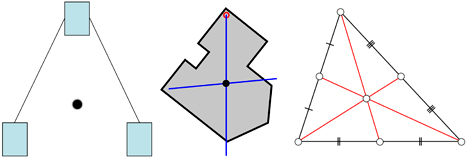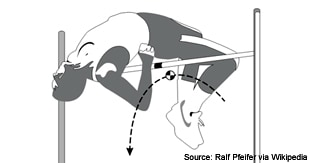Imagine the reaction if footballers started playing backwards, using the heels of their feet to propel the ball forwards. They’d probably be laughed off the pitch, if they didn’t trip over first. Athletes rarely deviate from traditional techniques simply because they work so well, but sometimes one individual can revolutionise an entire sport. These trendsetters include Dick Fosbury, a high jumper who took advantage of a neat mathematical trick to propel himself into the record books at the 1968 Olympics.
Over and under
High jumpers have to get their body over the pole if they want to win, but nothing says they have to do it all at once. Before Fosbury came, along the standard high jump technique was the straddle. Jumpers would get one leg over the bar and then roll over to clear the other one, much like a rider climbs on top of a horse. Fosbury’s innovation was to jump backwards, getting his upper body above the bar first before flicking his legs up and over. Although the Fosbury flop was seen as eccentric at first, it quickly became the dominant high-jump technique thanks to its lower centre of mass.
The centre of mass is the point representing the mean location of all the mass in a system. If you’ve ever balanced a ruler on the tip of your finger then you’ve found its centre of mass, with exactly half of the ruler’s mass on each side. The centre of mass doesn’t always correspond to an object’s physical centre though, and it can even lie outside of it all together.

Athletes using the Fosbury flop take advantage of this by curving their body to push their centre of mass below them. The best jumpers curve so much that their centre of mass actually passes under the high-jump bar, even though their body passes over. That’s a significant advantage when it comes to record-breaking, because raising your centre of mass is very hard work!
Free energy
You probably know that lifting an object requires energy to counteract the force of gravity, and that the energy needed to raise an object of mass m to a height of h is mgh, where g is the acceleration due to gravity. Even the best high jumpers don’t have leg muscles strong enough to generate this energy from just a standing leap, so they take the jump in three stages: the run-up, the take-off, and flight.
Our hopeful high jumper begins by running in a straight path to build up speed and kinetic energy, then curves slightly before reaching the pole so that they can turn around in mid air. In the take-off, they plant one foot firmly on the ground and push, converting forward momentum into upward momentum as they leap into the air. Once airborne, their centre of mass follows the path of a parabola, the shape you get from drawing y = -x².
A high jumper’s maximum height is u²sin²?/2g, where u and ? are the speed and angle of the initial launch. The skill lies in maximising these two values to achieve the greatest height possible, but remember it’s the centre of mass that reaches this height, and not necessarily the jumper’s whole body. By lowering an athlete’s centre of mass below their body, the Fosbury flop effectively provides extra height without having to put in extra effort. It’s no surprise then that Fosbury’s technique has dominated the high jump ever since – after all, everyone likes to get something for nothing.
Related Links
Maths and Sport: Countdown to the Games
‘Maths and Sport: Countdown to the Games’ is an exciting new project from the award-winning Millennium Mathematics Project at the University of Cambridge. To celebrate London 2012 they are developing free online mathematical articles and activities exploring maths and science through the Olympic and Paralympic Games, aimed at a wide audience from school students and their teachers to members of the public.






